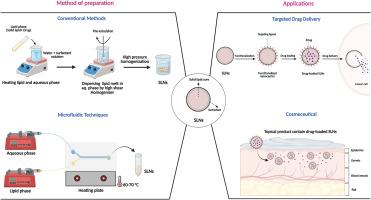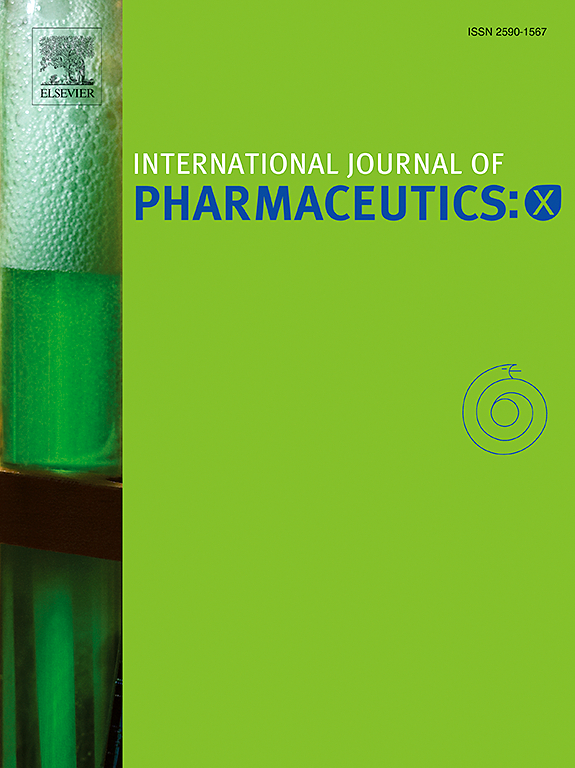制备固体脂质纳米颗粒的先进微流体技术:创新和生物医学应用
IF 6.4
2区 医学
Q1 PHARMACOLOGY & PHARMACY
引用次数: 0
摘要
固体脂质纳米颗粒(sln)是一种很有前途的纳米载体,可用于医药和化妆品领域,为亲水性和亲脂性化合物提供增强的药物保护、控释和靶向递送。传统的制备方法,如高压均质和溶剂乳化蒸发,面临着一些挑战,包括增加的多分散性、结垢限制和有害残留溶剂的存在。微流控技术已经成为制备sln的一种新方法,通过促进对颗粒尺寸、形态和封装效率的增强控制,解决了诸如可变粒径和残留溶剂等问题。微流体通过微尺度流体动力学实现快速均匀的混合,从而产生具有可调特性的均匀纳米颗粒。本文综述了微流控SLN制备的关键参数,并对各种微流控芯片设计和混合技术进行了详细的分类,说明了它们在控制纳米颗粒性能方面的独特优势。此外,本文提供了微流控SLN制备的全面概述,强调其相对于传统方法的优势,并探讨了SLN在推进药物输送系统,化妆品配方和诊断方面的变革潜力。还讨论了人工智能(AI)和机器学习的集成,以优化合成条件,提高工业翻译的可重复性和可扩展性。本文章由计算机程序翻译,如有差异,请以英文原文为准。

Advanced microfluidic techniques for the preparation of solid lipid nanoparticles: Innovations and biomedical applications
Solid lipid nanoparticles (SLNs) represent a promising category of nanocarriers used in medicine and cosmetics, offering enhanced drug protection, controlled release, and targeted delivery for both hydrophilic and lipophilic compounds. Conventional preparation methods, such as high-pressure homogenization and solvent emulsification-evaporation, face several challenges, including increased polydispersity, scaling limitations, and the presence of hazardous residual solvents. Microfluidic technology has emerged as a novel approach for preparing SLNs, addressing issues such as variable particle sizes and residual solvents by facilitating enhanced control over particle dimensions, morphology, and encapsulation efficiency. Microfluidics enables rapid and uniform mixing through micro-scale fluid dynamics, resulting in the production of homogeneous nanoparticles with adjustable characteristics. The review examines key parameters in microfluidic SLN preparation and categorizes various microfluidic chip designs and mixing techniques in detail, illustrating their unique advantages in controlling nanoparticle properties. Furthermore, this article provides a comprehensive overview of microfluidic SLN preparation, emphasizing its advantages over conventional methods, and explores the transformative potential of SLNs for advancing drug delivery systems, cosmetic formulations, and diagnostics. The integration of artificial intelligence (AI) and machine learning to optimize synthesis conditions and enhance reproducibility and scalability for industrial translation are also discussed.
求助全文
通过发布文献求助,成功后即可免费获取论文全文。
去求助
来源期刊

International Journal of Pharmaceutics: X
Pharmacology, Toxicology and Pharmaceutics-Pharmaceutical Science
CiteScore
6.60
自引率
0.00%
发文量
32
审稿时长
24 days
期刊介绍:
International Journal of Pharmaceutics: X offers authors with high-quality research who want to publish in a gold open access journal the opportunity to make their work immediately, permanently, and freely accessible.
International Journal of Pharmaceutics: X authors will pay an article publishing charge (APC), have a choice of license options, and retain copyright. Please check the APC here. The journal is indexed in SCOPUS, PUBMED, PMC and DOAJ.
The International Journal of Pharmaceutics is the second most cited journal in the "Pharmacy & Pharmacology" category out of 358 journals, being the true home for pharmaceutical scientists concerned with the physical, chemical and biological properties of devices and delivery systems for drugs, vaccines and biologicals, including their design, manufacture and evaluation. This includes evaluation of the properties of drugs, excipients such as surfactants and polymers and novel materials. The journal has special sections on pharmaceutical nanotechnology and personalized medicines, and publishes research papers, reviews, commentaries and letters to the editor as well as special issues.
 求助内容:
求助内容: 应助结果提醒方式:
应助结果提醒方式:


